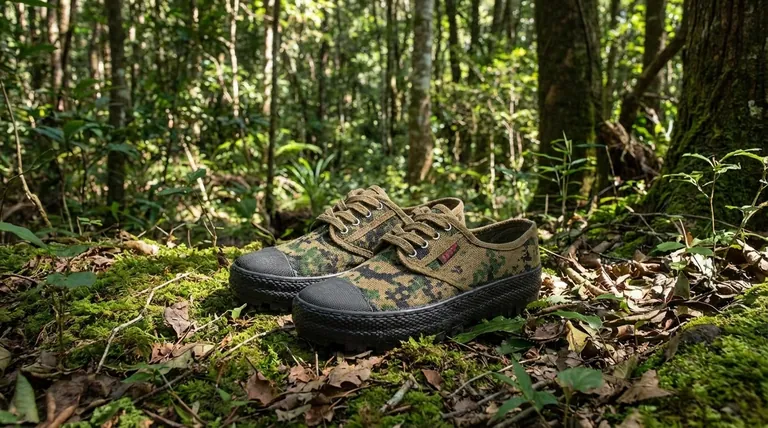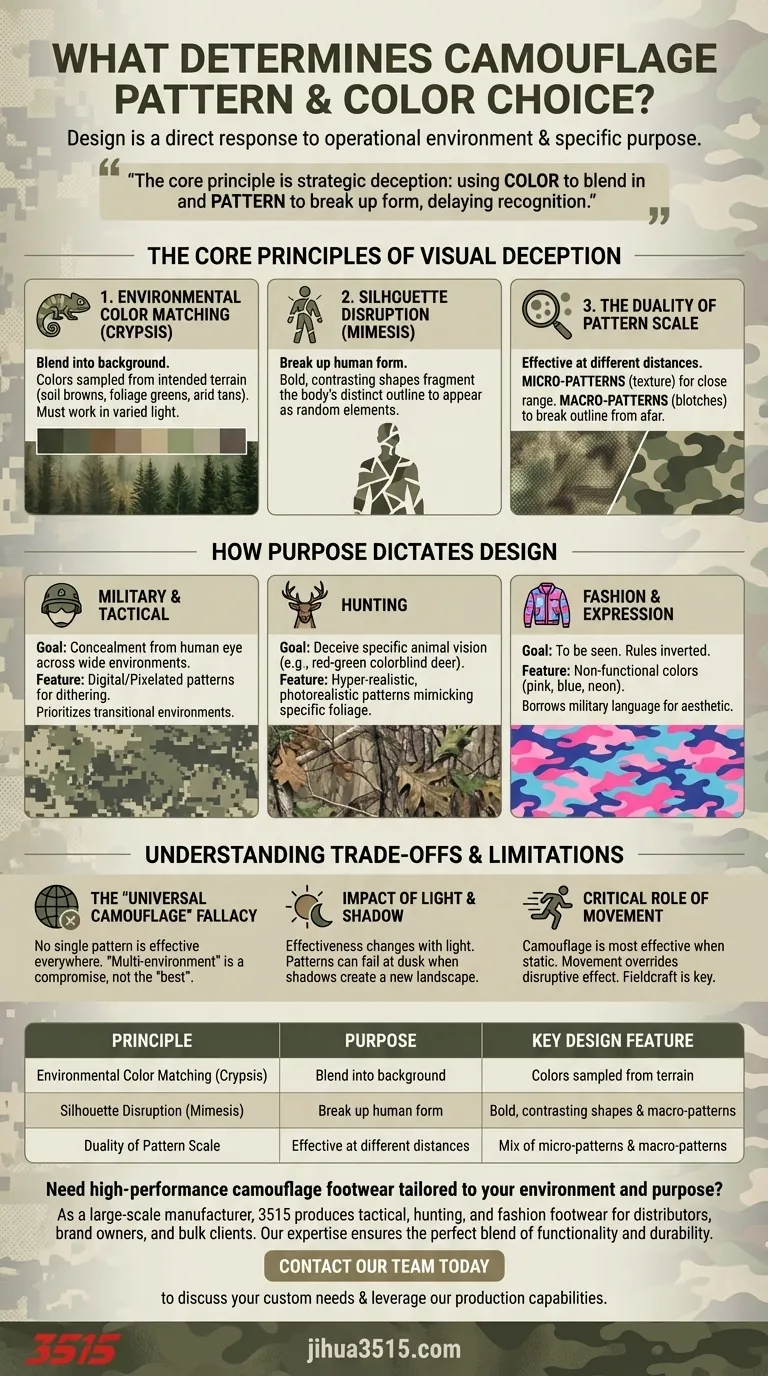The design of any camouflage is a direct response to two factors: its intended operational environment and its specific purpose. The colors are chosen to match the ambient terrain and light, while the pattern is engineered to break up the recognizable human silhouette, deceiving the observer's eye.
The core principle of effective camouflage is not about achieving literal invisibility. It is about strategic deception, using a combination of color (to blend in) and pattern (to break up form) that delays recognition by an observer.

The Core Principles of Visual Deception
Effective camouflage operates on two fundamental levels of visual psychology. Understanding these principles is key to understanding why certain patterns work and others fail.
Principle 1: Environmental Color Matching (Crypsis)
The first and most basic function is to match the color palette of the surrounding environment. This is known as crypsis.
The colors used in a pattern are sampled directly from the intended terrain—the browns of soil, the greens of foliage, the tans of arid sand. This allows the wearer to blend into the background "noise."
Effective color matching also accounts for the quality of light. A forest pattern, for instance, must work in the dappled light under a tree canopy as well as in open, bright clearings.
Principle 2: Silhouette Disruption (Mimesis)
The human brain is exceptionally good at recognizing the human form. Even if the colors match, the distinct outline of a head, shoulders, and torso is a dead giveaway.
The role of the pattern is to break up this silhouette, a concept called mimesis. Bold, contrasting shapes are used to fragment the body's outline, making it appear as a random collection of disconnected elements.
Principle 3: The Duality of Pattern Scale
The most sophisticated camouflage patterns use a mix of scales to be effective at different distances.
Micro-patterns are small, detailed elements that mimic the texture of the immediate surroundings, like leaves or pebbles. These are critical for avoiding detection at close range.
Macro-patterns are large, high-contrast blotches or shapes. Their purpose is to break up the body's main outline from a distance. A pattern without a strong macro-pattern will "blob out" at a distance, becoming a single, easily identifiable shape.
How Purpose Dictates Design
The application of these principles changes dramatically depending on the user's goal. The "best" camouflage is entirely context-dependent.
For Military & Tactical Use
The goal here is concealment from the human eye across the widest possible range of environments and distances.
Modern military patterns are often digital or pixelated. This approach uses small squares of color to create a dithering effect that blends more effectively into natural textures than traditional smooth-edged patterns.
These patterns prioritize transitional environments, attempting to provide reasonable concealment in woodland, arid, and urban settings without being perfect in any single one.
For Hunting Use
Hunting camouflage is highly specialized. It is designed to deceive the specific vision of a target animal, not necessarily a human.
For example, since deer are red-green colorblind, the precise shade of green is less important than the pattern's contrast and ability to break up the human form.
Many hunting patterns are hyper-realistic, using photorealistic images of bark, leaves, and branches to perfectly match a very specific type of terrain.
For Fashion & Expression
In fashion, the rules of concealment are inverted. The purpose is not to hide but to be seen.
Fashion camouflage borrows the visual language and authority of military patterns but uses it for aesthetic expression. The colors are often intentionally non-functional—like pink, blue, or neon orange—to make a statement.
Understanding the Trade-offs and Limitations
No camouflage pattern is a magic cloak of invisibility. Every design comes with inherent compromises.
The "Universal Camouflage" Fallacy
There is no such thing as a single pattern that is effective everywhere. A design optimized for a dense green forest will stand out starkly in a tan-colored desert.
So-called "multi-environment" patterns are a compromise. They are designed to be "good enough" in many places but are rarely the "best" option for any specific one.
The Impact of Light and Shadow
A pattern's effectiveness is entirely dependent on the lighting conditions. A pattern that works well in the bright, direct sun can fail completely at dusk, when strong shadows create a different visual landscape.
The Critical Role of Movement
Camouflage is most effective when the subject is static. The moment a person moves, the human eye's motion-detection capability overrides the pattern's disruptive effect. Fieldcraft and movement discipline are just as important as the pattern itself.
Making the Right Choice for Your Goal
Your choice should be dictated entirely by your primary objective.
- If your primary focus is military or tactical effectiveness: Prioritize patterns with a strong macro-pattern to disrupt your silhouette at a distance and that are designed for a broad range of transitional environments.
- If your primary focus is hunting a specific animal: Choose a pattern that mimics the exact foliage of your hunting ground and is designed to fool the visual perception of your target.
- If your primary focus is fashion or personal expression: Select any pattern or color that aligns with your aesthetic, as the technical principles of concealment do not apply.
Ultimately, the most effective camouflage is a system where pattern, color, and user discipline work in harmony to master the surrounding environment.
Summary Table:
| Principle | Purpose | Key Design Feature |
|---|---|---|
| Environmental Color Matching (Crypsis) | Blend into background | Colors sampled from terrain (browns, greens, tans) |
| Silhouette Disruption (Mimesis) | Break up human form | Bold, contrasting shapes and macro-patterns |
| Duality of Pattern Scale | Effective at different distances | Mix of micro-patterns (texture) and macro-patterns (outline) |
Need high-performance camouflage footwear tailored to your environment and purpose?
As a large-scale manufacturer, 3515 produces a comprehensive range of tactical, hunting, and fashion footwear for distributors, brand owners, and bulk clients. Our expertise in material science and pattern application ensures your footwear delivers the perfect blend of functionality and durability.
Contact our team today to discuss your custom camouflage footwear needs and leverage our full production capabilities.
Visual Guide

Related Products
- Wholesale Durable Camo Canvas Shoes with High-Traction Rubber Soles
- Wholesale Leather Business Casual Shoes with Dial Closure - Manufacturer of Comfort Dress Sneakers
- Customizable Anti-Smash Safety Boots for Wholesale & Private Label Manufacturing
- Premium Wholesale Waterproof Safety Boots High Performance Protection for Industrial Markets
- Custom Wholesale Leather Safety Boots Direct Factory Manufacturing
People Also Ask
- How does ASTM differ from ANSI? Navigating the U.S. Standards System for Compliance
- What is ASTM International and what does it do? A Guide to Global Standards
- What are the benefits of brisk walking? Boost Heart Health, Mood & Fitness
- What types of clothing are not considered business casual? Avoid These Common Style Mistakes
- What are the common environments where hazardous chemicals are present? Identify Key Risk Zones & Hazards















